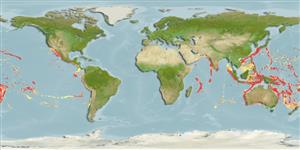Common names from other countries
Environment: milieu / climate zone / depth range / distribution range
Sinh thái học
Sống nổi và đáy; Mức độ sâu 200 - 1475 m (Ref. 96667). Deep-water; 33°N - 40°S, 54°E - 71°W
Indo-Pacific.
Length at first maturity / Bộ gần gũi / Khối lượng (Trọng lượng) / Age
Maturity: Lm ? range ? - ? cm
Typically found near the sea floor in deep-seas. Its characteristic 3 pairs of extremely long, stilt-like pereiopods suggest its ability to walk on soft sediments. An opportunistic feeder, relying on phototrophically derived organic matter. Its feeding strategy may be assumed to be similar with its congener, N. exilis, a scavenger and predator that feeds mainly on fish remains and slow-moving benthic organisms. Shown to produce oval eggs (0.5 to 0.65 mm length) and may possibly achieve several reproductive outputs in its relatively long lifespan of 2 to 3 years (Ref. 97382).
Life cycle and mating behavior
Chín muồi sinh dục | Sự tái sinh sản | Đẻ trứng | Các trứng | Sự sinh sản | Ấu trùng
Members of the order Decapoda are mostly gonochoric. Mating behavior: Precopulatory courtship ritual is common (through olfactory and tactile cues); usually indirect sperm transfer.
Poupin, J. 1998. (Ref. 75706)
IUCN Red List Status (Ref. 130435)
CITES status (Ref. 108899)
Not Evaluated
Not Evaluated
Human uses
| FishSource |
Các công cụ
Thêm thông tin
Age/Size
Sự sinh trưởng
Length-weight
Length-length
Hình thái học
Ấu trùng
Sự phong phú
Các nguồn internet
Estimates based on models
Preferred temperature
(Ref.
115969): 6 - 12.8, mean 8.3 (based on 423 cells).
Price category
Unknown.
